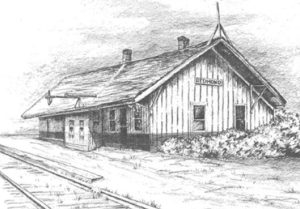A pioneering and innovative spirit has been a hallmark of the city of Redmond since it was founded in the 1880s, fueled by the efforts of Warren Wentworth Perrigo and Captain Luke McRedmond who were the first to stake their claim on the north side of rail-served Lake Sammamish. From vulnerabilities such as forest fire to a profitable lumber industry supporting steamboat and railway transportation, and the incorporation of public services permitting saloon businesses to thrive – Redmond has proven its resilience and unmatched success.
Pioneers Stake their Claim
The pioneers Warren Wentworth Perrigo and Captain Luke McRedmond were the first to stake their claim on the north end of Lake Sammamish. Faced with the difficult task of clearing the towering trees, the early settlers developed an innovative solution: burning the trunks above the roots. This ingenious solution soon led to Redmond’s first economic boom as loggers poured into the valley in the 1880s. John Peterson built the first sawmill east of Lake Sammamish in Issaquah, followed shortly by the Campbell Mill at Campton in 1905. These prosperous lumber and shingle operations created a demand for products and services, contributing to Redmond’s growing success and prosperity.

To meet the demands of this burgeoning economy, steamboats became the main form of transportation in the area, swiftly carrying goods and passengers up and down the Sammamish River until the Chittenden Locks opened in 1916. Redmond’s future was then secured with the arrival of the Seattle Lake Shore & Eastern Railway in 1888, the year before Washington became a state. This proud history of innovation and progress is what makes Redmond such a vibrant and successful community today.
The city’s first brick building, the Redmond Trading Company, and other historic landmarks, such as Bill Brown’s Garage, the Old Redmond Schoolhouse, the Brown Building, and the Redmond State Bank, serve as a reminder of the town’s impressive past. Despite devastating fires, Redmond was able to incorporate in 1912, establishing a public water system and allowing the city to collect taxes from its thriving saloons, which helped pave the way for its current prosperity.
The Vision of Frederick A. Reil
Redmond was born out of the vision of its first mayor, Frederick A. Reil, and blossomed beneath his leadership. The town saw many new buildings constructed Downtown, and Main Street (now Leary Way) became a bustling hub of automobile traffic. In 1916, Washington State adopted Prohibition four years ahead of the nation, prompting an abundance of bootlegging operations and liquor stills in the nearby woods. As the timber industry lost momentum due to aggressive logging during past decades, Redmond shifted its focus towards agriculture. Farmers worked hard to clear the massive stumps left behind by loggers and fenced off the land for dairy cattle, chickens, mink, and acres of berries. Although the population remained small during the Depression, Redmond held steadfast and continues to thrive today.
Early History
Redmond is a city with a proud history of resourcefulness and community participation. From the early days of steamboats and horse-drawn stages to the completion of the Evergreen Point floating bridge in 1963, Redmond has consistently harnessed superior infrastructure to fuel its growth. With only 503 residents at the opening of the first Lake Washington floating bridge, Redmond’s population exploded to 43,610 by the millennium due to the flourishing high-tech industrial sector that emerged in the 1970s. The people of Redmond continue to look towards the future with optimism, confident that their tradition of innovation will bring continued success.
Redmond has gained international recognition for its innovative and forward-thinking approach to life, developed by the early settlers who boldly styled a profitable living out of thin air, inspired by the timber industry that followed. Its pioneering spirit powered it through trying times and enabled it to evolve and develop into the vibrant community it is known as today—its impressive legacy is immortalized in brick monuments, old buildings, steamboats, and rails alike. The long arc story of Redmond—from an un photographer glade to a thriving city—indubitably left a mark on the collective history of Washington State and offers an inspiring testament that anything can be possible with ingenuity, hard work, and determination.
[button link=”https://experienceredmond.com/visit/redmond-history/” newwindow=”yes”]Learn More[/button]
